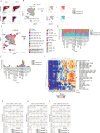Tissue-resident memory T cells from a metastatic vaginal melanoma patient are tumor-responsive T cells and increase after anti-PD-1 treatment
- PMID: 35550554
- PMCID: PMC9109124
- DOI: 10.1136/jitc-2022-004574
Tissue-resident memory T cells from a metastatic vaginal melanoma patient are tumor-responsive T cells and increase after anti-PD-1 treatment
Abstract
Background: Vaginal melanoma (VM) is a rare cancer and has a poor response to immune checkpoint blockade (ICB). CD8+Tissue Resident Memory (TRM) T cells proliferate in response to ICB and correlate with longer survival in metastatic cutaneous melanoma. However, their capacity to respond to VM and their neoantigens is not known.
Methods: Using longitudinal samples, we explored the evolution of VM mutations by whole-exome sequencing and RNAseq, we also defined the immune context using multiplex immunohistochemistry and nanostring pan cancer immune profile. Then using fresh single cell suspensions of the metastatic samples, we explored VM T cells via mass cytometry and single cell RNAseq and T cell receptor sequencing (TCRseq). Finally, we investigated TRM, pre-TRM and exhausted T cell function against melanoma neo-antigens and melanoma differentiation antigens in vitro.
Results: Primary VM was non-inflamed and devoid of CD8+ TRM cells. In contrast, both metastases showed proliferating CD8+ TRM were clustered at the tumor margin, with increased numbers in the second ICB-refractory metastasis. The first metastasis showed dense infiltration of CD8+ T cells, the second showed immune exclusion with loss of melanoma cell Major histocompatibility complex (MHC)-I expression associated with downregulation of antigen presentation pathway gene expression. CD8+ TRM from both metastases responded to autologous melanoma cells more robustly than all other CD8+ T cell subsets. In addition, CD8+ TRM shared TCR clones across metastases, suggesting a response to common antigens, which was supported by recognition of the same neoantigen by expanded tumor infiltrating lymphocytes.
Conclusions: In this study, we identified TRM clusters in VM metastases from a patient, but not primary disease. We showed TRM location at the tumor margin, and their superior functional response to autologous tumor cells, predicted neoantigens and melanoma differentiation antigens. These CD8+ TRM exhibited the highest tumor-responsive potential and shared their TCR with tumor-infiltrating effector memory T cells. This suggests VM metastases from this patient retain strong antitumor T cell functional responses; however, this response is suppressed in vivo. The loss of VG MHC-I expression is a common immune escape mechanism which was not addressed by anti-PD-1 monotherapy; rather an additional targeted approach to upregulate MHC-I expression is required.
Keywords: CD8-Positive T-Lymphocytes; Immune Evation; Immunotherapy; Melanoma.
© Author(s) (or their employer(s)) 2022. Re-use permitted under CC BY-NC. No commercial re-use. See rights and permissions. Published by BMJ.
Conflict of interest statement
Competing interests: AP, NK and SPK were supported by imCORE, F. Hoffmann-La Roche. MP is an employee of F. Hoffmann-La Roche. DEG has been on advisory board for Amgen, Q Biotics, Provectus and Bayer. SS has been receiving advisory board fees, paid to her institution, and grant support from AstraZeneca and Merck Sharp & Dohme, and grant support from Amgen, Endocyte, and Genentech.
Figures





References
-
- St Clair C, Wethington S, Eaton A, eds. Vulvar and vaginal melanoma——a single institutional experience 1995–2012. 44th Annual Meeting on Women’s Cancer, 2013.
Publication types
MeSH terms
Substances
LinkOut - more resources
Full Text Sources
Medical
Research Materials
